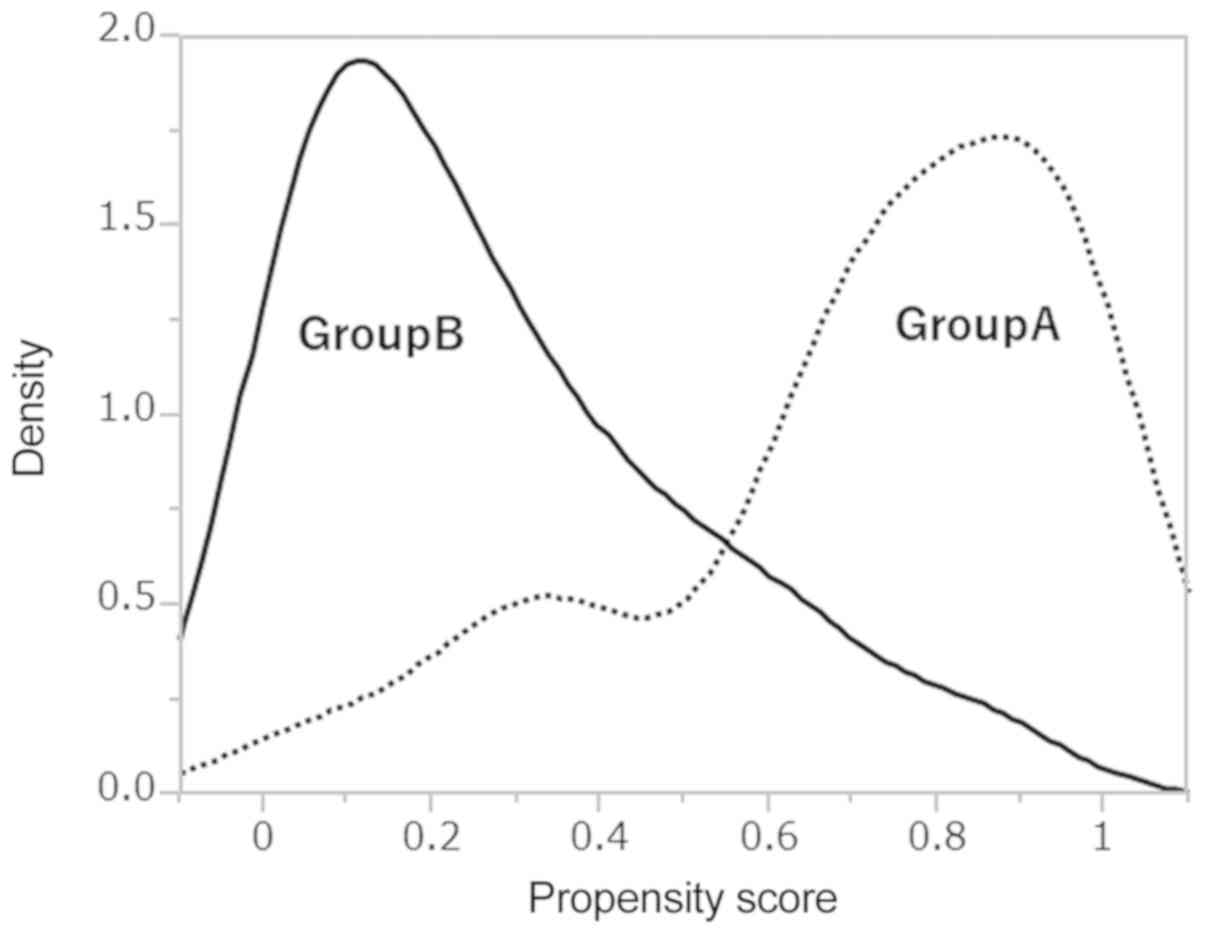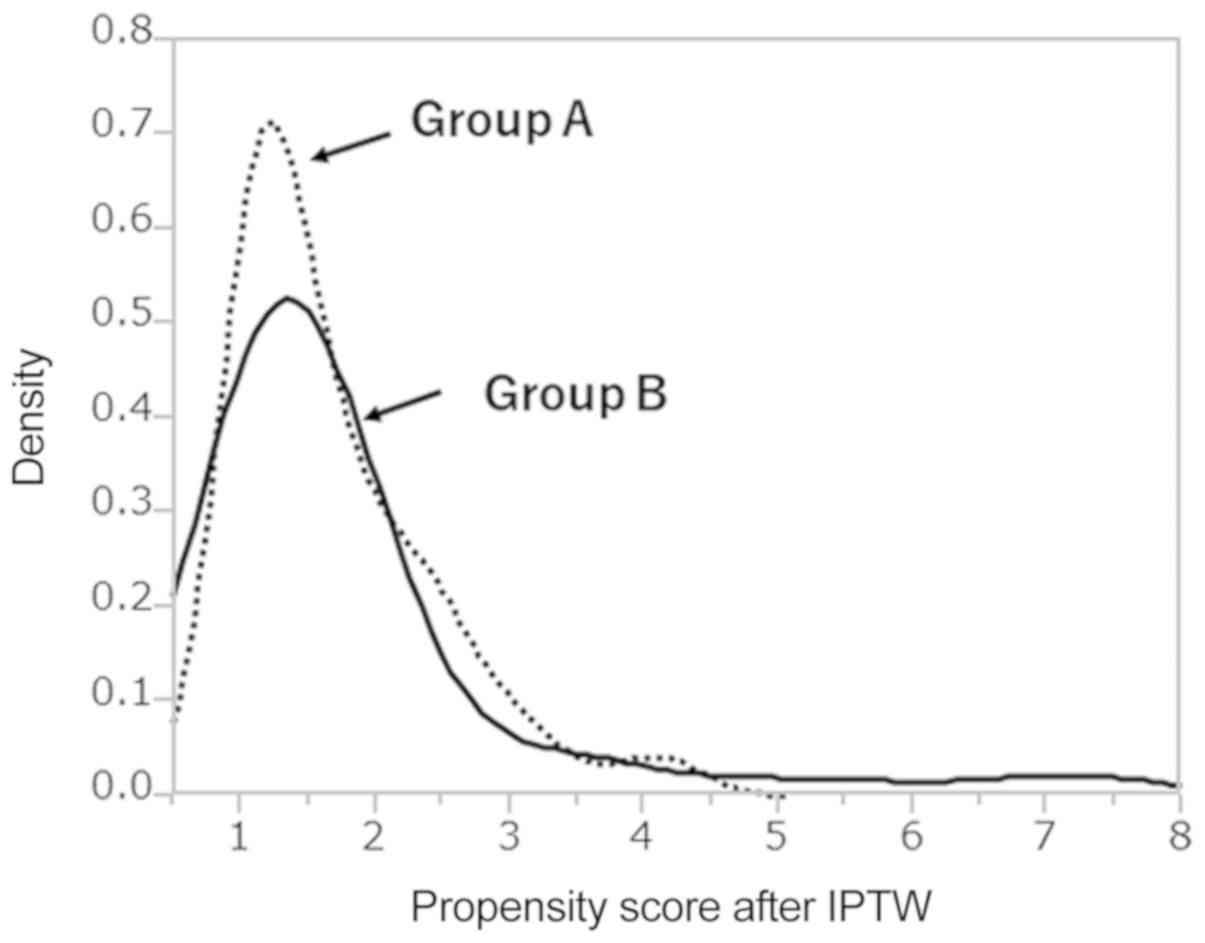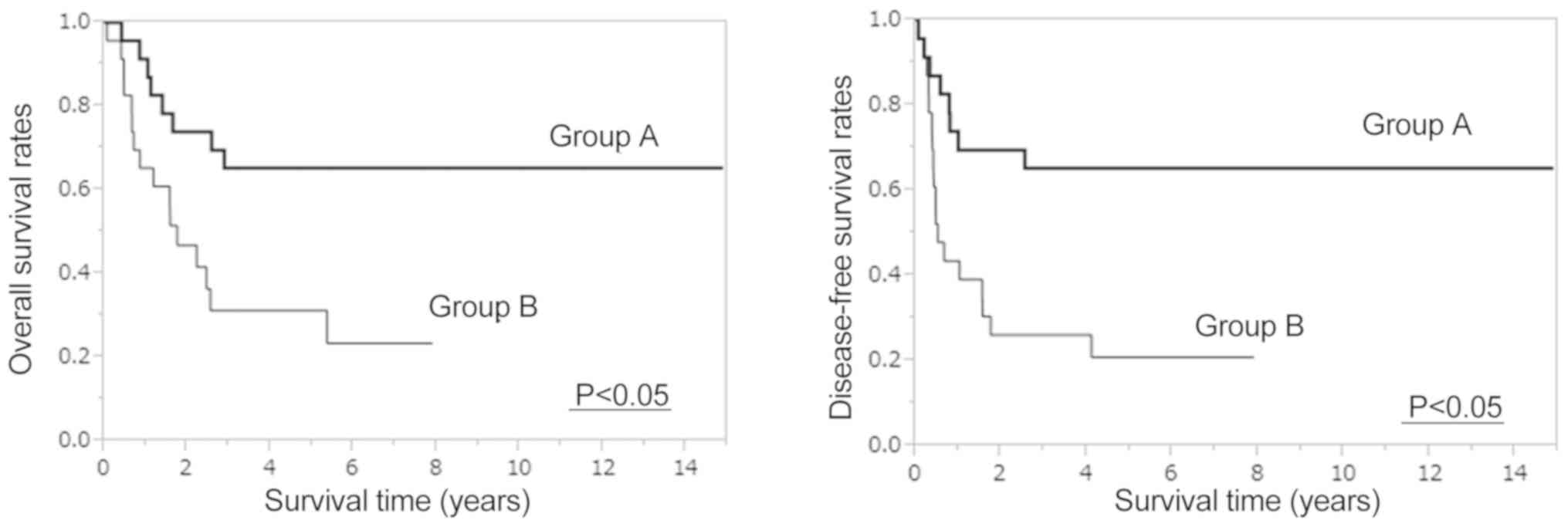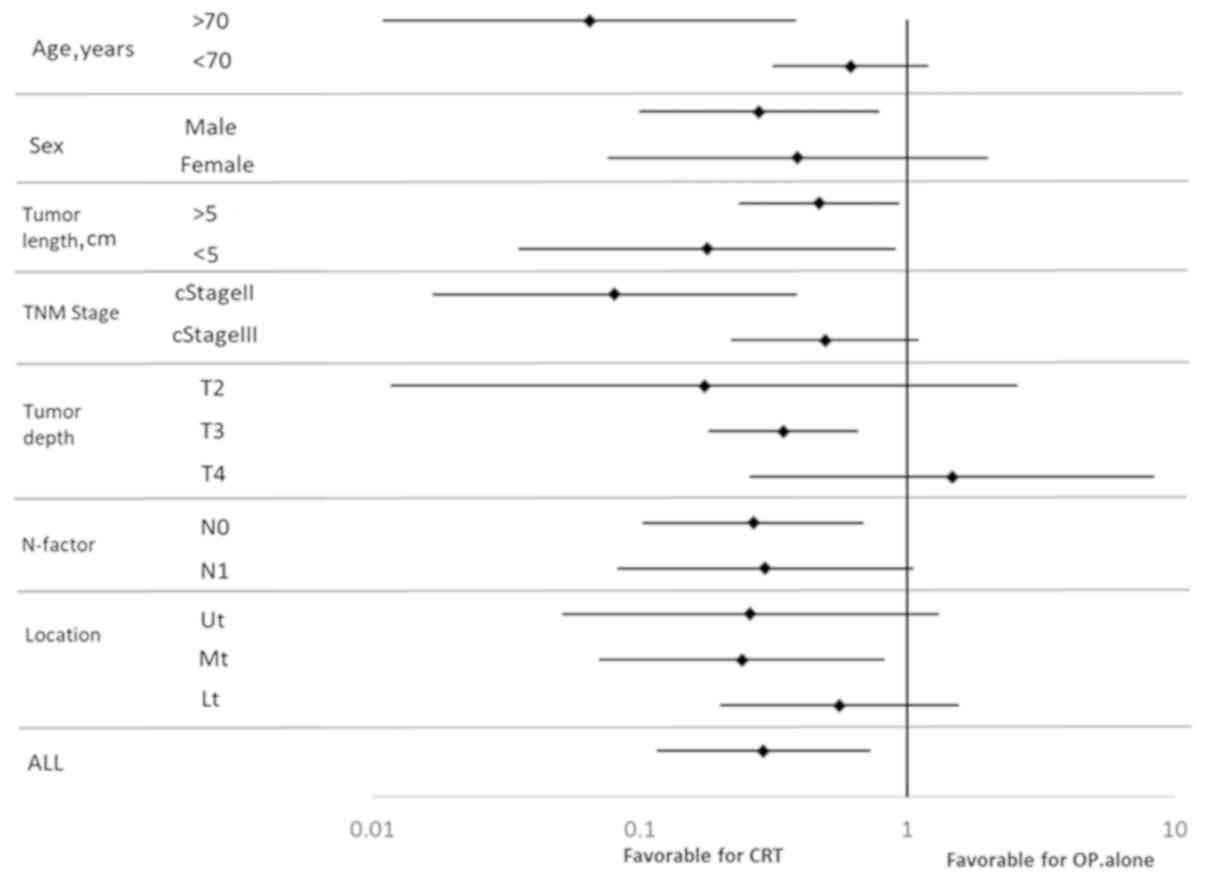|
1
|
Roth JA and Putnam JB Jr: Surgery for
cancer of the esophagus. Semin Oncol. 21:453–461. 1994.PubMed/NCBI
|
|
2
|
Tachimori Y, Ozawa S, Numasaki H,
Fujishiro M, Matsubara H, Oyama T, Shinoda M, Toh Y, Udagawa H and
Uno T; Registration Committee for Esophageal Cancer of the Japan
Esophageal Society, : Comprehensive registry of esophageal cancer
in Japan, 2009. Esophagus. 13:110–137. 2016. View Article : Google Scholar : PubMed/NCBI
|
|
3
|
Dresner SM and Griffin SM: Pattern of
recurrence following radical oesophagectomy with two-field
lymphadenectomy. Br J Surg. 87:1426–1433. 2000. View Article : Google Scholar : PubMed/NCBI
|
|
4
|
Hulscher JB, van Sandick JW, Tijssen JG,
Obertop H and van Lanschot JJ: The recurrence pattern of esophageal
carcinoma after transhiatal resection. J Am Coll Surg. 191:143–148.
2000. View Article : Google Scholar : PubMed/NCBI
|
|
5
|
Nakagawa S, Kanda T, Kosugi S, Ohashi M,
Suzuki T and Hatakeyama K: Recurrence pattern of squamous cell
carcinoma of the thoracic esophagus after extended radical
esophagectomy with three-field lymphadenectomy. J Am Coll Surg.
198:205–211. 2004. View Article : Google Scholar : PubMed/NCBI
|
|
6
|
Isono K, Sato H and Nakayama K: Results of
a nationwide study on the three-field lymph node dissection of
esophageal cancer. Oncology. 48:411–420. 1991. View Article : Google Scholar : PubMed/NCBI
|
|
7
|
Ajani JA and D'Amico TA: Esophageal and
Esophagogastric Junction Cancers in NCCN Clinical Practice
Guidelines in Oncology (NCCN Guidelines version 1.2018). https://www.nccn.org/professionals/physician_gls/pdf/esophageal.pdf
|
|
8
|
Ando N, Kato H, Igaki H, Shinoda M, Ozawa
S, Shimizu H, Nakamura T, Yabusaki H, Aoyama N, Kurita A, et al: A
randomized trial comparing postoperative adjuvant chemotherapy with
cisplatin and 5-fluorouracil versus preoperative chemotherapy for
localized advanced squamous cell carcinoma of the thoracic
esophagus (JCOG9907). Ann Surg Oncol. 19:68–74. 2012. View Article : Google Scholar : PubMed/NCBI
|
|
9
|
Fujiwara Y, Kamikonya N, Inoue T, Koishi
K, Yoshikawa R, Nakao K, Yagyu R, Nishiwaki M, Fujiwara M, Kojima
S, et al: Chemoradiotherapy for T3 and T4 squamous cell carcinoma
of the esophagus using low-dose FP and radiation: A preliminary
report. Oncol Rep. 14:1177–1182. 2005.PubMed/NCBI
|
|
10
|
Fujiwara Y, Yoshikawa R, Kamikonya N,
Nakayama T, Kitani K, Tsujie M, Yukawa M, Inoue M and Yamamura T:
Trimodality therapy of esophagectomy plus neoadjuvant
chemoradiotherapy improves the survival of clinical stage II/III
esophageal squamous cell carcinoma patients. Oncol Rep. 28:446–452.
2012. View Article : Google Scholar : PubMed/NCBI
|
|
11
|
Fujiwara Y, Yoshikawa R, Kamikonya N,
Nakayama T, Kitani K, Tsujie M, Yukawa M, Hara J, Yamamura T and
Inoue M: Neoadjuvant chemoradiotherapy followed by esophagectomy
vs. surgery alone in the treatment of resectable esophageal
squamous cell carcinoma. Mol Clin Oncol. 1:773–779. 2013.
View Article : Google Scholar : PubMed/NCBI
|
|
12
|
Austin PC: The performance of different
propensity score methods for estimating marginal hazard ratios.
Stat Med. 32:2837–2849. 2013. View
Article : Google Scholar : PubMed/NCBI
|
|
13
|
Sobin LH and Wittekind C: International
Union Against Cancer (UICC). TNM Classification of Malignant Tumors
(6th). Wiley-Liss. (New York). 2002.
|
|
14
|
Eisenhauer EA, Therasse P, Bogaerts J,
Schwartz LH, Sargent D, Ford R, Dancey J, Arbuck S, Gwyther S,
Mooney M, et al: New response evaluation criteria in solid tumours:
Revised RECIST guideline (version 1.1). Eur J Cancer. 45:228–247.
2009. View Article : Google Scholar : PubMed/NCBI
|
|
15
|
Weitzen S, Lapane KL, Toledano AY, Hume AL
and Mor V: Principles for modeling propensity scores in medical
research: A systematic literature review. Pharmacoepidemiol Drug
Saf. 13:841–853. 2004. View
Article : Google Scholar : PubMed/NCBI
|
|
16
|
Austin PC: A critical appraisal of
propensity-score matching in the medical literature between 1996
and 2003. Stat Med. 27:2037–2049. 2008. View Article : Google Scholar : PubMed/NCBI
|
|
17
|
Austin PC, Grootendorst P, Normand SL and
Anderson GM: Conditioning on the propensity score can result in
biased estimation of common measures of treatment effect: A monte
carlo study. Stat Med. 26:754–768. 2007. View Article : Google Scholar : PubMed/NCBI
|
|
18
|
Austin PC: The performance of different
propensity-score methods for estimating relative risks. J Clin
Epidemiol. 61:537–545. 2008. View Article : Google Scholar : PubMed/NCBI
|
|
19
|
Austin PC: The performance of different
propensity-score methods for estimating differences in proportions
(risk differences or absolute risk reductions) in observational
studies. Stat Med. 29:2137–2148. 2010. View
Article : Google Scholar : PubMed/NCBI
|
|
20
|
Austin PC: The performance of different
propensity score methods for estimating marginal odds ratios. Stat
Med. 26:3078–3094. 2007. View
Article : Google Scholar : PubMed/NCBI
|
|
21
|
Guttmann DM, Mitra N, Metz JM, Plastaras
J, Feng W and Swisher-McClure S: Neoadjuvant chemoradiation is
associated with improved overall survival in older patients with
esophageal cancer. J Geriatr Oncol. 9:40–46. 2018. View Article : Google Scholar : PubMed/NCBI
|
|
22
|
Yendamuri S, Malhotra U, Hennon M, Miller
A, Groman A, Halloon A and Reid ME: Clinical characteristics of
adenosquamous esophageal carcinoma. J Gastrointest Oncol. 8:89–95.
2017. View Article : Google Scholar : PubMed/NCBI
|
|
23
|
Fiteni F, Paget-Bailly S, Messager M,
N'Guyen T, Lakkis Z, Mathieu P, Lamfichekh N, Picard A, Benzidane
B, Cléau D, et al: Docetaxel, Cisplatin, and 5-Fluorouracil as
perioperative chemotherapy compared with surgery alone for
resectable gastroesophageal adenocarcinoma. Cancer Med.
5:3085–3093. 2016. View
Article : Google Scholar : PubMed/NCBI
|
|
24
|
Kim S, Paget-Bailly S, Messager M, Nguyen
T, Mathieu P, Lamfichekh N, Fein F, Fratté S, Cléau D, Lakkis Z, et
al: Perioperative docetaxel, cisplatin, and 5-fluorouracil compared
to standard chemotherapy for resectable gastroesophageal
adenocarcinoma. Eur J Surg Oncol. 43:218–225. 2017. View Article : Google Scholar : PubMed/NCBI
|
|
25
|
Lordick F, Mariette C, Haustermans K,
Obermannová R and Arnold D; ESMO guidelines committee, :
oesophageal cancer: ESMO clinical practice guidelines for
diagnosis, treatment and follow-up. Ann Oncol. 27 (Suppl
5):v50–v57. 2016. View Article : Google Scholar : PubMed/NCBI
|
|
26
|
Kranzfelder M, Schuster T, Geinitz H,
Friess H and Büchler P: Meta-analysis of neoadjuvant treatment
modalities and definitive non-surgical therapy for oesophageal
squamous cell cancer. Br J Surg. 98:768–783. 2011. View Article : Google Scholar : PubMed/NCBI
|
|
27
|
Sjoquist KM, Burmeister BH, Smithers BM,
Zalcberg JR, Simes RJ, Barbour A and Gebski V; Australasian
Gastro-Intestinal Trials Group, : Survival after neoadjuvant
chemotherapy or chemoradiotherapy for resectable oesophageal
carcinoma: An updated meta-analysis. Lancet Oncol. 12:681–692.
2011. View Article : Google Scholar : PubMed/NCBI
|
|
28
|
Markar SR, Karthikesalingam A, Thrumurthy
S and Low DE: Volume-outcome relationship in surgery for esophageal
malignancy: Systematic review and meta-analysis 2000–2011. J
Gastrointestinal Surg. 16:1055–1063. 2012. View Article : Google Scholar
|
|
29
|
Shapiro J, van Lanschot JJB, Hulshof MCCM,
van Hagen P, van Berge Henegouwen MI, Wijnhoven BPL, van Laarhoven
HWM, Nieuwenhuijzen GAP, Hospers GAP, Bonenkamp JJ, et al: CROSS
study group: Neoadjuvant chemoradiotherapy plus surgery versus
surgery alone for oesophageal or junctional cancer (CROSS):
Long-term results of a randomised controlled trial. Lancet Oncol.
16:1090–1098. 2015. View Article : Google Scholar : PubMed/NCBI
|
|
30
|
Burmeister BH, Smithers BM, Gebski V,
Fitzgerald L, Simes RJ, Devitt P, Ackland S, Gotley DC, Joseph D,
Millar J, et al: Surgery alone versus chemoradiotherapy followed by
surgery for resectable cancer of the oesophagus: A randomised
controlled phase III trial. Lancet Oncol. 6:659–668. 2005.
View Article : Google Scholar : PubMed/NCBI
|















